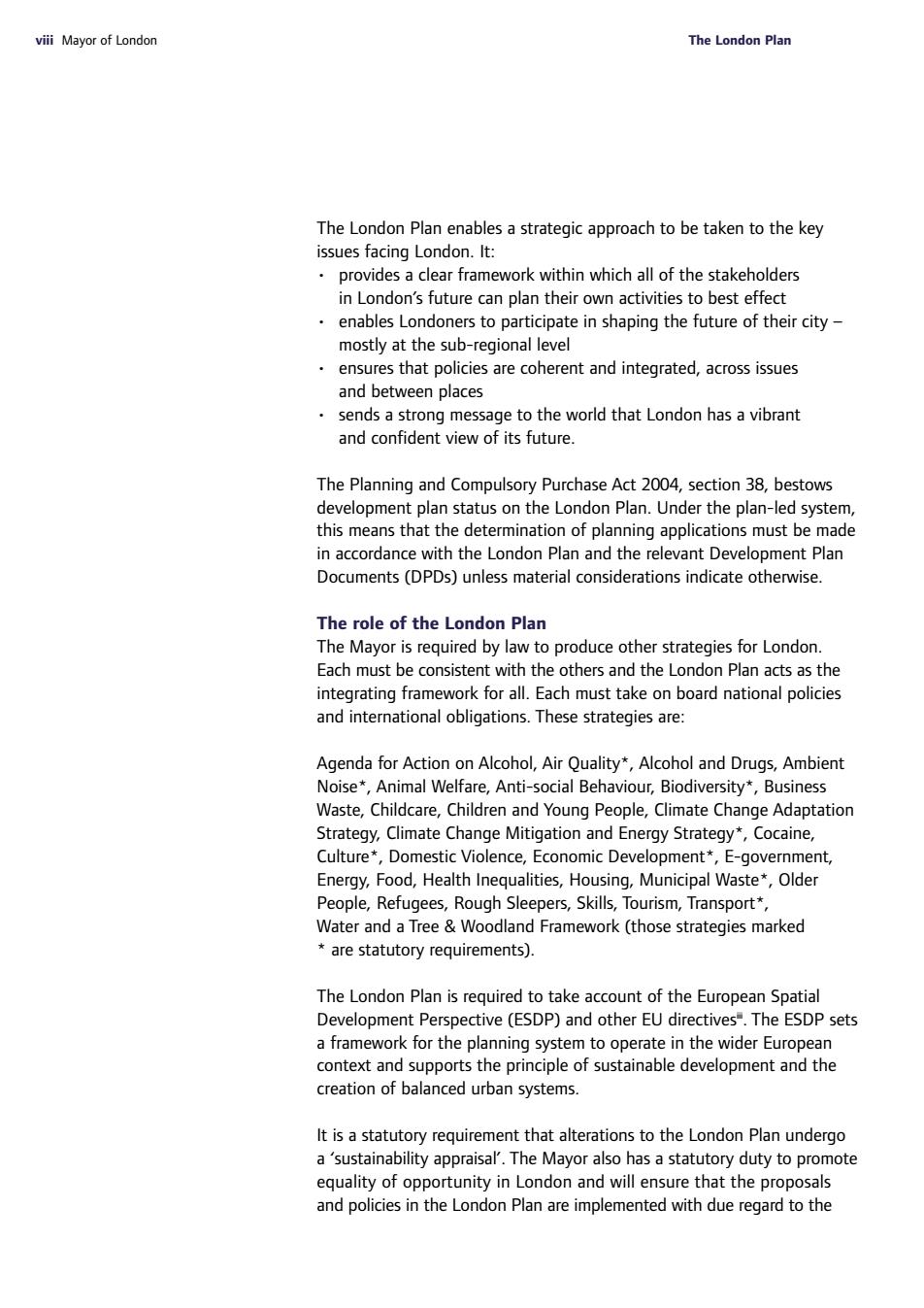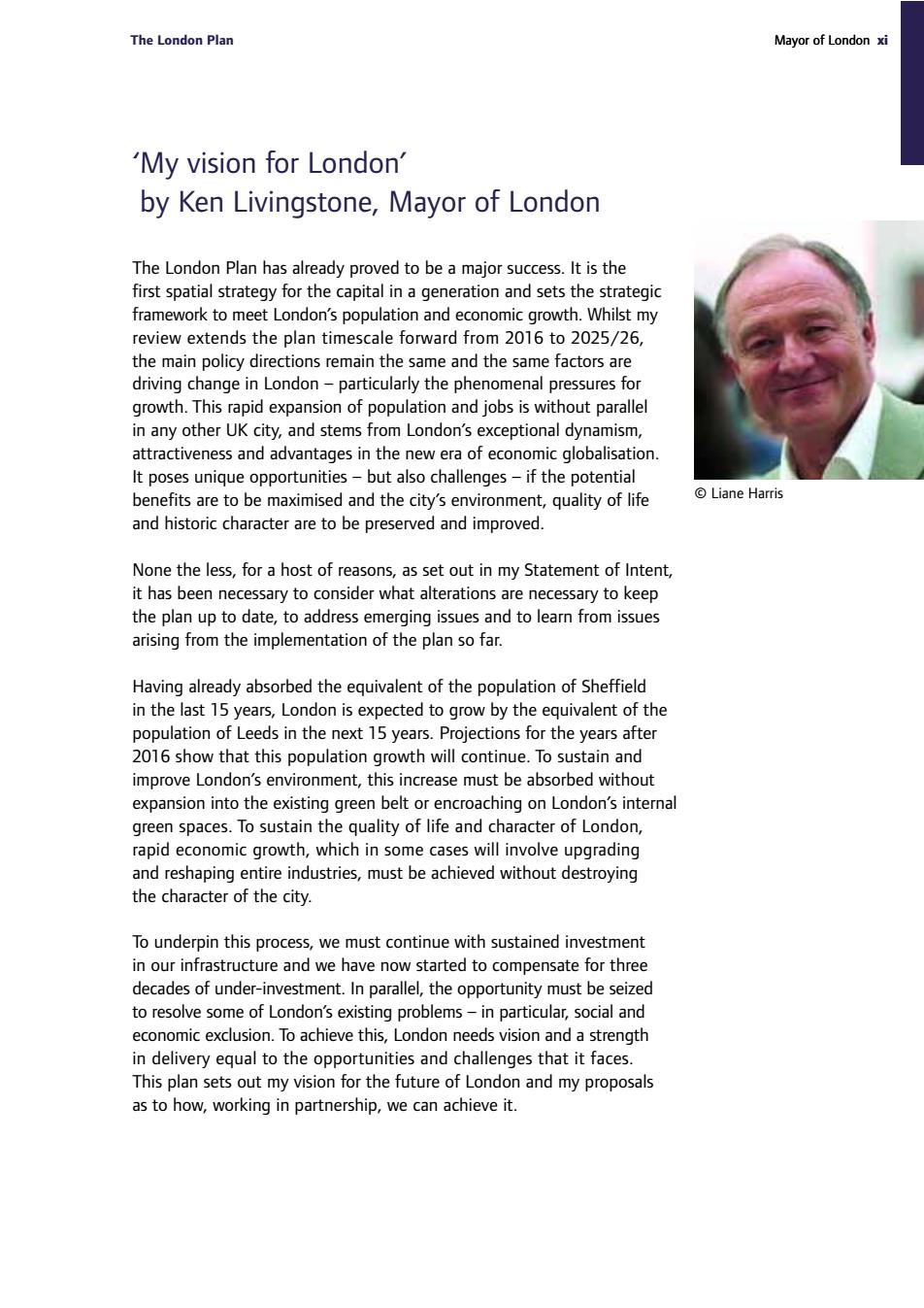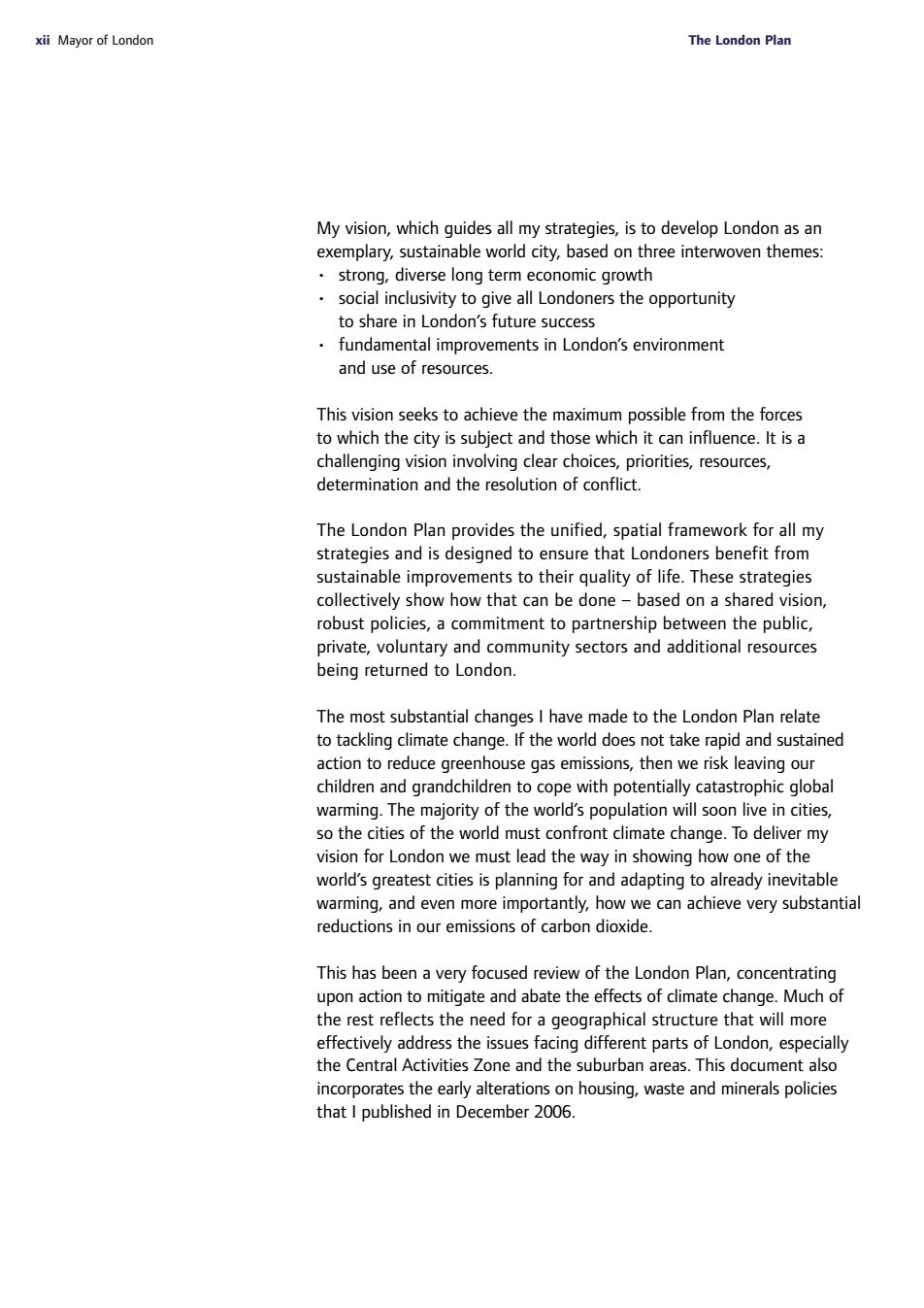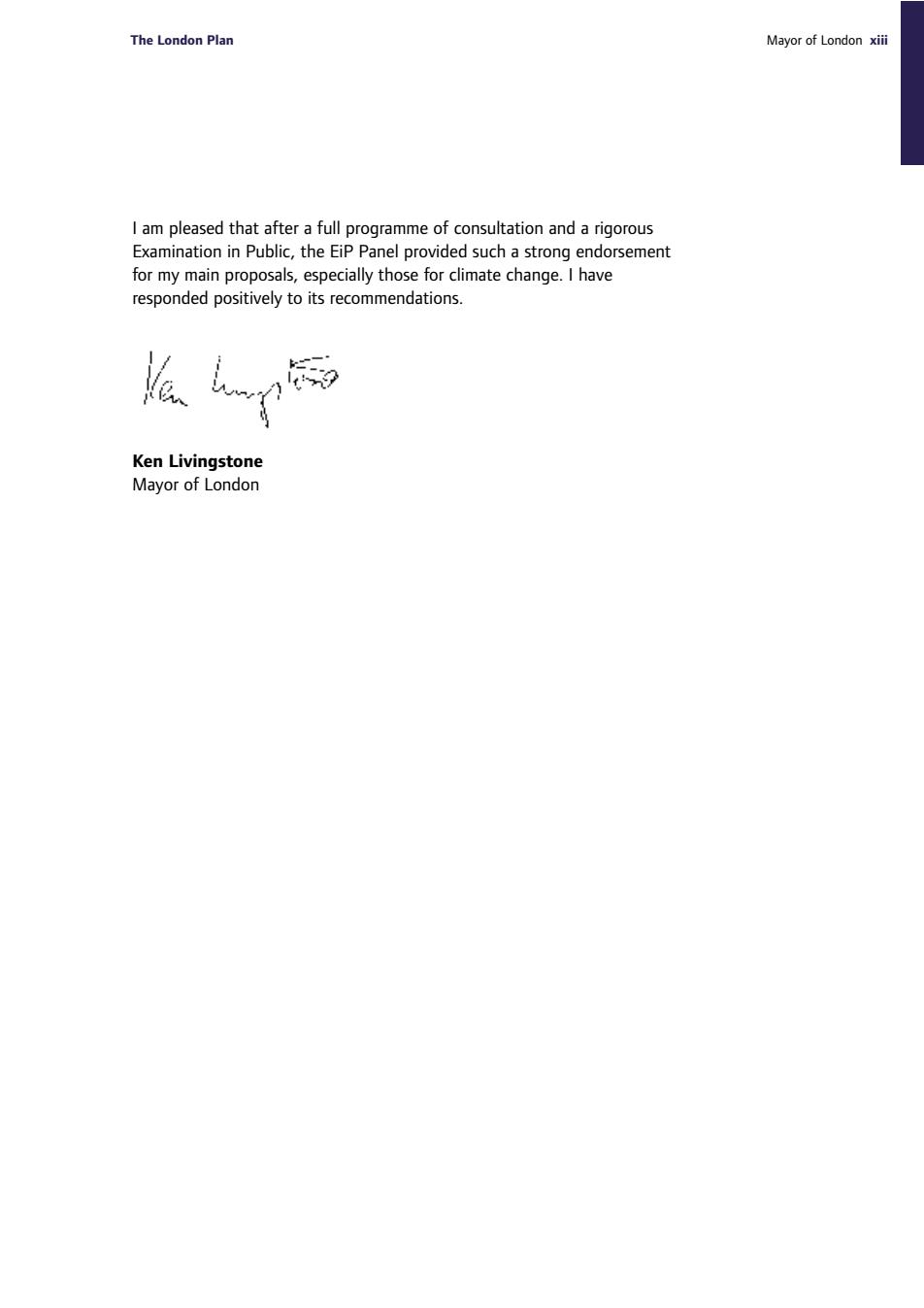
vii Mayor of London The London Plar The London Plan enables a strategic approach to be taken to the key issues facing London.It: provides a clear framework within which all of the stakeholders in London's future can plan their own activities to best effect enables Londoners to participate in shaping the future of their city mostly at the sub-regional level ensures that policies are coherent and integrated.across issues and between places sends a strong message to the world that London has a vibrant and confident view of its future The Planning and Compulsory Purchase Act 2004,section 38,bestows development plan status on the London Plan.Under the plan-led system, this means that the determination of planning applications must be made in accordance with the London Plan and the relevant Development Plan Documents(DPDs)unless material considerations indicate otherwise. The role of the London Plan The Mayor is required by law to produce other strategies for London Each must be nsistent with the othe and the london plar acts asth integrating ork for all.Ea ach must take e on boar national policie and international obligations.These strategies are Agenda for Action on Alcohol,Air Quality",Alcohol and Drugs,Ambient Noise,Animal Welfare,Anti-social Behaviour,Biodiversity,Business Waste,Childcare,Children and Young People,Climate Change Adaptation Strategy,Climate Change Mitigation and Energy Strategy*,Cocaine, Culture*.Domestic Violence,Economic Development*,E-government, Energy,Food,Health Inequalities,Housing,Municipal Waste*Older People.Refuo Skills Tou ism Tra Wate and a Framework (thos e strategies marked are statutory requirements) The London Plan is required to take account of the European Spatial Development Perspective (ESDP)and other EU directives".The ESDP sets a framework for the planning system to operate in the wider European context and supports the principle of sustainable development and the creation of balanced urban systems. astatutory requirement that atertions to theond Pan appraisal.The Mayo also has a statutory duty to pr opp ortunity in Londo and will e e th the propos and policies in the London Plan are implemented with due regard to the
viii Mayor of London The London Plan The London Plan enables a strategic approach to be taken to the key issues facing London. It: • provides a clear framework within which all of the stakeholders in London’s future can plan their own activities to best effect • enables Londoners to participate in shaping the future of their city – mostly at the sub-regional level • ensures that policies are coherent and integrated, across issues and between places • sends a strong message to the world that London has a vibrant and confident view of its future. The Planning and Compulsory Purchase Act 2004, section 38, bestows development plan status on the London Plan. Under the plan-led system, this means that the determination of planning applications must be made in accordance with the London Plan and the relevant Development Plan Documents (DPDs) unless material considerations indicate otherwise. The role of the London Plan The Mayor is required by law to produce other strategies for London. Each must be consistent with the others and the London Plan acts as the integrating framework for all. Each must take on board national policies and international obligations. These strategies are: Agenda for Action on Alcohol, Air Quality*, Alcohol and Drugs, Ambient Noise*, Animal Welfare, Anti-social Behaviour, Biodiversity*, Business Waste, Childcare, Children and Young People, Climate Change Adaptation Strategy, Climate Change Mitigation and Energy Strategy*, Cocaine, Culture*, Domestic Violence, Economic Development*, E-government, Energy, Food, Health Inequalities, Housing, Municipal Waste*, Older People, Refugees, Rough Sleepers, Skills, Tourism, Transport*, Water and a Tree & Woodland Framework (those strategies marked * are statutory requirements). The London Plan is required to take account of the European Spatial Development Perspective (ESDP) and other EU directivesiii. The ESDP sets a framework for the planning system to operate in the wider European context and supports the principle of sustainable development and the creation of balanced urban systems. It is a statutory requirement that alterations to the London Plan undergo a ‘sustainability appraisal’. The Mayor also has a statutory duty to promote equality of opportunity in London and will ensure that the proposals and policies in the London Plan are implemented with due regard to the

The London Plan Mayor of London ix Amendment Act 2000,the Disability Disc mination Acts 5ad ther relevant overment policy advice The London Plan has accordingly been formulated having had regard to the matters specified in sections 41 and 342(1)(a)of the Greater London Authority Act 1999 and Regulation 6(1)of the Town and Country Planning (London Spatial Development Strategy)Regulations 2000, to all relevant EU directives and UK legislation,and to Government advice and regional planning guidance.The London Plan is subject to an ongoing epstTPubishedamay itoring and managing change and a monitoring The plan takes the year 2025/26 a of the targets and statistics relate to earlier years(especially 2016) because information is more readily available and/or reliable for those dates.Preparation of Alterations has been informed by a parallel scenario development and policy testing exercise". References Department of Transport,Local Government and the Regions. Planning:De SegetoigefrlontcSCrtaionDatcaLaauh Government Office for London.RPG3 Regional Planning Guidance:Strategic Planning trategic Planning Guidance for the River Thames GOl 1997 WCytn0ppe9aph2a
The London Plan Mayor of London ix Race Relations Amendment Act 2000, the Disability Discrimination Acts 1995 and 2005 and other relevant government policy advice. The London Plan has accordingly been formulated having had regard to the matters specified in sections 41 and 342 (1)(a) of the Greater London Authority Act 1999 and Regulation 6(1) of the Town and Country Planning (London Spatial Development Strategy) Regulations 2000, to all relevant EU directives and UK legislation, and to Government advice and regional planning guidance. The London Plan is subject to an ongoing process of monitoring and managing change and a monitoring report is published annually. The plan takes the year 2025/26 as its formal end date because the Mayor believes a long-term view of London’s future is needed. Many of the targets and statistics relate to earlier years (especially 2016) because information is more readily available and/or reliable for those dates. Preparation of Alterations has been informed by a parallel scenario development and policy testing exerciseiv . References i Department of Transport, Local Government and the Regions. Planning: Delivering a fundamental change. HMSO, 2001 Government Office for London. Circular 1/2000. Strategic Planning in London. DETR, 2000 Government Office for London. Consultation Draft GoL Circular. Strategic Planning in London, GOL, 2008 ii Government Office for London. RPG 3 Regional Planning Guidance: Strategic Planning Guidance for London Planning Authorities. HMSO 1996 Government Office for London. RPG3b: Strategic Planning Guidance for the River Thames GOL, 1997 iii GoL Circular 1/2000 op cit, paragraph 2.8 iv Berkeley Hanover Consulting, BWA, Michael Ling. Further Alterations to the London Plan: Scenario Development and Policy Testing Project. GLA, 2006

The London Plan Mayor of London xi 'My vision for London' by Ken Livingstone,Mayor of London The London Plan has already proved to be a major success.It is the first spatial strategy for the capital in a generation and sets the strategic framework to meet london's population and economic arowth.whilst my review extends the plan timescale forward from 2016 to 2025/26 ma npolicydire ns remain the nd the actors nge i partic y the pl nnother UK citnrom ondom id tion and jobs is wit attractiveness and advantages in the new era of economic globalisation. It poses unique opportunities-but also challenges-if the potential benefits are to be maximised and the city's environment,quality of life liane harri and historic character are to be preserved and improved. None the less,for a host of reasons,as set out in my Statement of Intent, it has been nec ider what alterati the plar up to date nd to learn fi Having already absorbed the equivalent of the population of Sheffield in the last 15 years,London is expected to grow by the equivalent of the population of Leeds in the next 15 years.Projections for the years after 2016 show that this population growth will continue.To sustain and improve London's environment.this increase must be absorbed without expansion into the existing green belt or encroaching on London's internal the y and char acter of ondon wth,whic h in will inv upgra en re industries,must be achieved without destroying To underpin this process,we must continue with sustained investment in our infrastructure and we have now started to compensate for three decades of under-investment.in parallel.the opportunity must be seized to resolve some of london's existina problems-in particular social and economic exclusion.To achieve this,London needs vision and a strength in delivery equal to the opportunities and challenges that it face This for the future of londo and my proposals as to how,working in partnership,we can achieve it
The London Plan Mayor of London xi The London Plan has already proved to be a major success. It is the first spatial strategy for the capital in a generation and sets the strategic framework to meet London’s population and economic growth. Whilst my review extends the plan timescale forward from 2016 to 2025/26, the main policy directions remain the same and the same factors are driving change in London – particularly the phenomenal pressures for growth. This rapid expansion of population and jobs is without parallel in any other UK city, and stems from London’s exceptional dynamism, attractiveness and advantages in the new era of economic globalisation. It poses unique opportunities – but also challenges – if the potential benefits are to be maximised and the city’s environment, quality of life and historic character are to be preserved and improved. None the less, for a host of reasons, as set out in my Statement of Intent, it has been necessary to consider what alterations are necessary to keep the plan up to date, to address emerging issues and to learn from issues arising from the implementation of the plan so far. Having already absorbed the equivalent of the population of Sheffield in the last 15 years, London is expected to grow by the equivalent of the population of Leeds in the next 15 years. Projections for the years after 2016 show that this population growth will continue. To sustain and improve London’s environment, this increase must be absorbed without expansion into the existing green belt or encroaching on London’s internal green spaces. To sustain the quality of life and character of London, rapid economic growth, which in some cases will involve upgrading and reshaping entire industries, must be achieved without destroying the character of the city. To underpin this process, we must continue with sustained investment in our infrastructure and we have now started to compensate for three decades of under-investment. In parallel, the opportunity must be seized to resolve some of London’s existing problems – in particular, social and economic exclusion. To achieve this, London needs vision and a strength in delivery equal to the opportunities and challenges that it faces. This plan sets out my vision for the future of London and my proposals as to how, working in partnership, we can achieve it. ‘My vision for London’ by Ken Livingstone, Mayor of London © Liane Harris

xi Mayor of London The London Plar strong,diverse long term economic growth social inclusivity to give all Londoners the opportunity to share in London's future success fundamental improvements in London's environment and use of resources. This vision seeks to achieve the maximum possible from the forces to which the ssubject and The London Plan provides the unified,spatial framework for all my strategies and is designed to ensure that Londoners benefit from sustainable improvements to their quality of life.These strategies collectively show how that can be done-based on a shared vision, robust policies.a commitment to partnership between the public. ontetorndaddtionresources The most substantial changes I have made to the London Plan relate to tackling climate change.If the world does not take rapid and sustained action to reduce greenhouse gas emissions,then we risk leaving our children and grandchildren to cope with potentially catastrophic global warming.The majority of the world's population will soon live in cities, so the cities of the world must confront climate change.To deliver my vision for London we must lead the way in showing how one of the world's greatest cities is planning for and adapting to already inevitable and avo ntly,how achiev very substantial r emissions of carbon dioxide This has been a very focused review of the London Plan,concentrating upon action to mitigate and abate the effects of climate change.Much of the rest reflects the need for a geographical structure that will more effectively address the issues facing different parts of London,especially the Central Activities Zone and the suburban areas.This document also incorporates the early alterations on housing,waste and minerals policies that i published in December 2006
xii Mayor of London The London Plan My vision, which guides all my strategies, is to develop London as an exemplary, sustainable world city, based on three interwoven themes: • strong, diverse long term economic growth • social inclusivity to give all Londoners the opportunity to share in London’s future success • fundamental improvements in London’s environment and use of resources. This vision seeks to achieve the maximum possible from the forces to which the city is subject and those which it can influence. It is a challenging vision involving clear choices, priorities, resources, determination and the resolution of conflict. The London Plan provides the unified, spatial framework for all my strategies and is designed to ensure that Londoners benefit from sustainable improvements to their quality of life. These strategies collectively show how that can be done – based on a shared vision, robust policies, a commitment to partnership between the public, private, voluntary and community sectors and additional resources being returned to London. The most substantial changes I have made to the London Plan relate to tackling climate change. If the world does not take rapid and sustained action to reduce greenhouse gas emissions, then we risk leaving our children and grandchildren to cope with potentially catastrophic global warming. The majority of the world’s population will soon live in cities, so the cities of the world must confront climate change. To deliver my vision for London we must lead the way in showing how one of the world’s greatest cities is planning for and adapting to already inevitable warming, and even more importantly, how we can achieve very substantial reductions in our emissions of carbon dioxide. This has been a very focused review of the London Plan, concentrating upon action to mitigate and abate the effects of climate change. Much of the rest reflects the need for a geographical structure that will more effectively address the issues facing different parts of London, especially the Central Activities Zone and the suburban areas. This document also incorporates the early alterations on housing, waste and minerals policies that I published in December 2006

The London Plan Mayor of London xi for my main proposals,especially those for climate change.I have responded positively to its recommendations
The London Plan Mayor of London xiii I am pleased that after a full programme of consultation and a rigorous Examination in Public, the EiP Panel provided such a strong endorsement for my main proposals, especially those for climate change. I have responded positively to its recommendations. Ken Livingstone Mayor of London